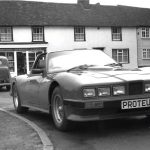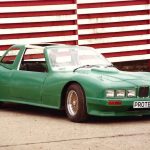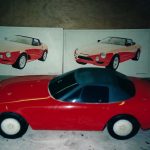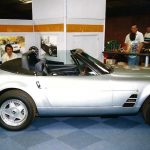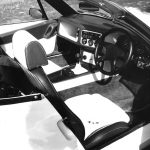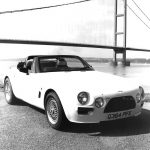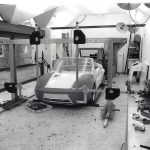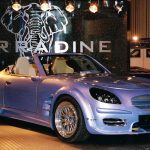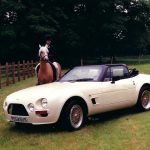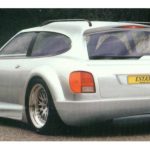A TRIBUTE TO JOHN PARRADINE – DELTAYN PROTEUS, PARRADINE PEGASUS & JJR 525S
I was very saddened to hear of the death this week of John Parradine, aged 72.
To regular readers and kitcar enthusiasts, John will need no introduction as he first appeared on the kitcar radar in 1985 with his Jaguar-based roadster the Deltayn Proteus.
John was always very kind to me and my first contact with him was when I worked for Kit Cars & Specials magazine in the eighties. We sponsored the Stoneleigh show back then and I was tasked with the job of arranging ‘interesting’ cars to appear on our showcase stand in the then new cowshed foyer area.
We invited John and he was delighted to put the Proteus on our stand for the weekend. That was the year (1987) when we also had John Raffo – and his Raffo Tipo 12 – on the stand. He brought along a mobile kitchen in the shape of a Commer van and proceeded to keep us in magnificent pasta all weekend.
John was born in Essex and his main day job was importing huge industrial dumper trucks – those massive ones you see being used for road building – among other similar equipment. It was certainly more than a bit of plant hire! John was very successful at it.
The Proteus came about because he fancied building a car and couldn’t really find exactly what he was looking for. The car was available in kit form and was based around Jaguar XJ mechanicals. It was pretty distinctive with its bank of three headlights on each side. The windscreen was a Citroën CX item. I wonder if back in 1985 John realised how significant France would play in his future career.
Deltayn Cars probably sold a handful of Proteus’ before John reverted back to 100 per cent concentration on his earthmoving equipment business. For a while …
Incidentally, I guess engineering was in John’s blood as in 1949 his father produced a full-scale robot elephant that was powered by a Ford four-cylinder engine! In case you ever wondered why John used an elephant outline on his badge this is the reason.
Not finished with car building. Far from it, John commissioned Richard Oakes to design a new car for him. This time he meant real business although he retained his beloved Jaguar donor components.
Trading under a new company name of Parradine Motor Company located in Appleby, near Scunthorpe the Pegasus, as the new car was named, was different gravy. A superb thing.
It was a sophisticated design and was claimed to be the world’s first production car to feature a full Kevlar/carbon-fibre bodyshell. From the outset, it caused a stir. Parradine’s intention was to sell it in fully built guise.
I remember a few clever clogs who may have scoffed at the six-headlight arrangement of the Proteus having to eat humble pie when they first saw the Pegasus. Showing his serious intent John booked a stand at the Geneva Motor Show of 1990, where it was officially launched.
A beefy spaceframe chassis underpinned proceedings with power coming from a tuned version of Jaguar’s XJ12 engine said to be good for around 350bhp. The luxurious interior looked very ergonomic and definitely up to the required standard. Trimmers, Callow & Maddox, more used to putting the interiors into Bentleys and Rolls-Royces, were given the job of creating a sumptuous interior environment befitting of a ‘from’ £92,000 car (approximately £142,201 today, allowing for inflation) and they sure came up trumps with swathes of Italian saddle leather and buckskin employed.
I’m not sure what the Parradines were expecting at the Geneva launch – a big step for a small company – but they surely couldn’t have been ready for the near 400 orders they received at the high-profile Swiss show, all of them backed up with a £5000 deposit. I remember John telling me that he was overwhelmed by public and trade responses.
A trade delegation from the French government was also very impressed and they scrabbled to get involved. They liked the idea of a supercar being built on French soil and it’s been said that President Mitterand himself was involved in the subsequent deal that saw John relocate his family and company to a purpose-built factory on the new industrial estate at Magny Cours race circuit (near Nevers, for geographical reference).
Not only that but then Jaguar boss, Sir John Egan liked the Pegasus so much he agreed to supply the major Jaguar running gear at a discounted rate, while well-known Jaguar engineer/designer (later of the reborn Lea Francis), Professor Jim Randall was also very involved.
By the time around nineteen cars had been built the wheels came off the Pegasus project. A couple of reasons have been given including a theory that domestic French car manufacturers weren’t happy so put continual pressure on the authorities. Another is that the first Gulf War in 1991 gave the government cold feet, particularly with a looming oil crisis on the horizon.
Rather than hold their nerve they pulled the plug. This left John with his dreams shattered. It should have been his ticket to the big time. It was certainly one of the prettiest and most cohesive specialist cars that I have ever seen.
Unfortunately, John had no option but to give the rest of the five grand deposits back and move back home to Humberside to lick his wounds. Several sales figures have been bandied about. The most reliable I’ve seen is that nineteen French-built cars were supplied. Perhaps three or more likely one was supplied later in kit form. Regardless, in an ideal world, John should have sold at least 10,000 Pegasus’.
Perfectly coining the term ‘you can’t keep a good man down’ John took a break before planning his next automotive venture. In 1998, now trading under the JJR Automotive banner to pave the way for his third attempt at car manufacturing, which was the Parradine 525S Roadster. At this time the company relocated to Market Rasen, Lincolnshire.
A modern interpretation of the Pegasus that again looked stunning. I remember seeing it at the launch at the British International Motorshow at the NEC in 2000.
Again, another automotive first for John Parradine – this time the first manufacturer to do away with external door mirrors in lieu of cameras and a monitor. Ahead of its time, for sure.
Among the menu of revisions were the adoption of Quantum H4 doors and the same car’s clever retractable roof system designed by Harvey Wooldridge. The Parradine was powered by a supercharged 4.6-litre version of the modular, quad-cam Ford Mustang V8 engine paired to a six-speed gearbox. All up weight was 1350kg. Again, this Parradine model was not available in kit form. Prices started around £130,000 (approximately £160,000, allowing for inflation, today).
The car was to be available in 430- and 525bhp variants, with two further body styles, the 525SC (Coupé) and 525SE (Estate) announced in 2001 and 2002 respectively.
The cars were available until around 2006 when the company quietly closed the shutters for the final time and John Parradine began to take things easier having poured his heart, soul and considerable funds into his car manufacturing exploits.
A very nice chap, an astute businessman and someone who had a real go in life. RIP mate, you’ll be missed and thank you for the memories.
We send our sincere condolences to John’s family and friends.
| Print article | This entry was posted by admin on March 9, 2023 at 6:49 pm, and is filed under Uncategorized. Follow any responses to this post through RSS 2.0. Both comments and pings are currently closed. |
Comments are closed.









